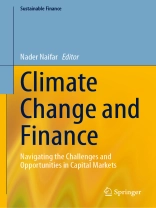Financial markets play a critical role in climate finance as they are a major source of funding for many of the projects and initiatives aimed at addressing climate change. For instance, banks and investors can provide loans and capital to companies that are developing renewable energy projects, building energy-efficient infrastructure, or implementing climate-smart agricultural practices. Moreover, the importance of climate finance in financial markets goes beyond just funding environmental initiatives. Investors and financial institutions are increasingly factoring in climate risks and opportunities into their decision-making processes, including assessing the financial risks posed by climate change and the potential impact of new regulations and policies aimed at reducing greenhouse gas emissions.
This book is a collection of recent developments in climate change and climate finance. As the global community seeks to address the impacts of climate change, financial institutions are being called upon to play a larger role in supporting the transition to a sustainable economy. This includes incorporating climate risks into investment decisions, developing new financial products that support climate-friendly investments, and promoting greater transparency and accountability in the financial sector. The book provides a comprehensive analysis of how climate change is impacting the global financial system and explores the potential solutions that can help address these challenges. The contributions aim to examine the complex interplay between climate change and finance, and the potential for innovative financial instruments and policies to support the transition to a low-carbon economy.
Cuprins
Part I: Green Finance and Investment Dynamics.- Chapter 1: Green Finance Initiatives and Their Potential to Drive Sustainable Development.- Chapter 2: Comparative Efficiency of Green Assets and Black Assets Around the Russo-Ukraine War.- Chapter 3: Does Foreign Green Finance Inspire Environmental, Social, and Governance Sustainability Metrics? Evidence from MENA Countries.- Chapter 4: Investor Attitudes and Preferences Toward Climate Change and Sustainable Investments: A Bibliometric Analysis.- Chapter 5: The Role of Financial Institutions in Addressing Climate Change.- Chapter 6: Green Development Prospects of Fossil Fuel Export-dependent Countries: A Case Study of the Caspian Sea Region.- Chapter 7: Financial System Readiness to Achieve Carbon Neutrality.- Part II: Climate Change, Policy, and Economic Governance.- Chapter 8: Emerging trends in climate change and global economic governance.- Chapter 9: Climate-Related Financial Regulations and Their Impact on Geotechnical Engineering.- Chapter 10: Linking environmental performance and financial profitability of companies under greenhouse gas emissions trading.- Part III: Sector-Specific Impacts and Strategies.- Chapter 11: The Impact of Carbon Emission and Energy Factors on Climate Change in BRICS Countries.- Chapter 12: A Nexus between Climate Change Risk and Financial Performance of Agricultural Businesses in a Developing Economy.- Chapter 13: Effects and Opportunities of Climate Change on a Company’s Goodwill.- Chapter 14: Harnessing the potential of green cryptocurrencies: a path towards climate change mitigation.- Chapter 15: Irrigating Arid Lands; Sustainable Development through Blue Sukuk.- Chapter 16: Green Finance Initiative – Accelerating Sustainable Development for a Green Future.
Despre autor
Dr. Nader Naifar is a Professor of Finance at the Imam Mohammad Ibn Saud Islamic University (IMSIU) in Riyadh, Saudi Arabia. He teaches Corporate Valuations, Advanced Topics in Finance, Real Estate Finance & Investment, Financial Management, and Corporate Finance, among others. His research focuses on energy markets, Islamic finance, credit derivatives, green finance, fintech, and financial stability.












